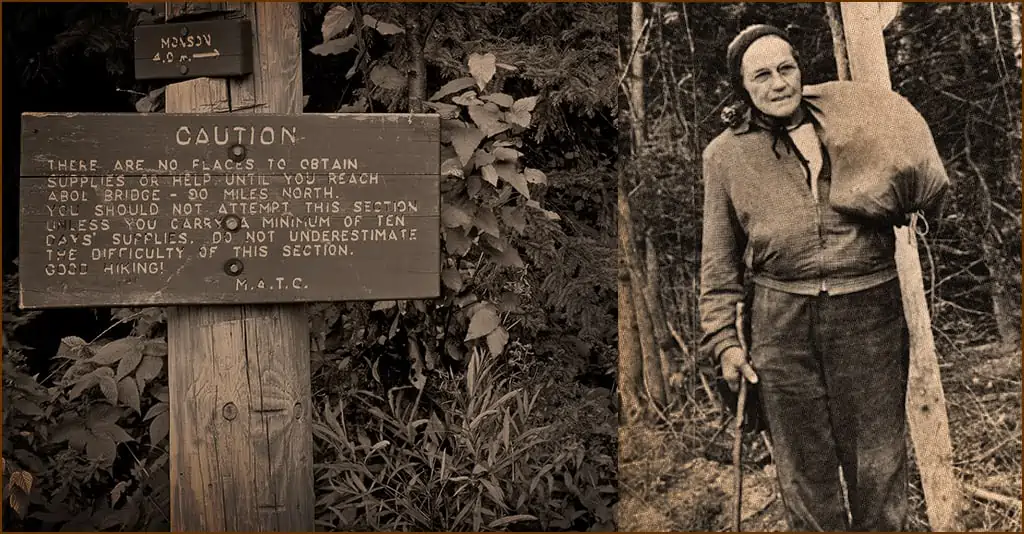
When, one hot day in July of 1954, Emma Gatewood told her grown kids she was “going for a walk,” she left out a few details. She expected the walk would take her from Maine to Georgia, cover 2,108.5 miles and go through 14 states.
Known as America’s most celebrated pedestrian and the woman who helped save the Appalachian Trail, 67-year-old “Grandma” Gatewood would become the first woman to hike the entire trail alone, in one season. She did it without a tent or sleeping bag, a hand-sewn sack with 12 pounds of gear slung over her shoulder, and nothing fancier than a pair of Converse high-tops on her feet.
Early hardscrabble life
Emma Rowena Caldwell was born in 1887 Ohio to a bitter Civil War veteran who drank and gambled, and a mother who struggled to raise 15 children in a small log cabin.

The nearby woods was where she found refuge, first from the endless farm chores her father demanded and, later, from her own husband. And though young Emma only finished eighth grade, she was naturally resourceful, learning about wildlife, plants, herbs, and which were edible or medicinal.
Inspired by National Geographic
In 1949 she read a National Geographic story about the first man to hike the Appalachian Trail within one year — and learned no woman had ever hiked it solo. Knowing a challenge when she saw one, Gatewood thought, “if that man could do it, so could I.” So, with no training, she started walking 10 miles a day to build up her legs.
That article led Gatewood to expect a beautiful, well-marked trail with clean shelters each night. Instead, she described what she found to reporters: “Terrible blow-downs, burnt-over areas that were never re-marked, gravel and sand washouts, weeds and brush to your neck, and shelters blown down, burnt out or so filthy I chose to sleep outdoors.” Had she known the actual conditions she would face, she admitted she would never have started her hike.
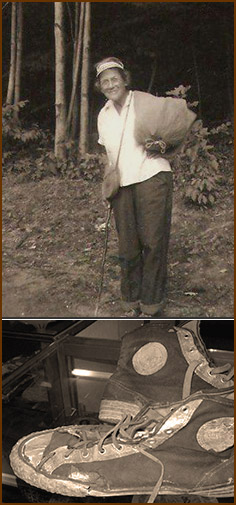
“Go home, Grandma”
But that day in July of 1954, an optimistic Emma Gatewood rode several buses from her home in Ohio to Maine where, for practice, she hiked from the base of Mount Katahdin to its summit and back. Next morning, she started walking south, toting only food, water, a plastic shower curtain for shelter, some adhesive Band-Aids and a change of clothes, all packed into a hand-sewn denim bag and wearing her preferred hiking shoes — sneakers.
To say things did not go well is an understatement. Gatewood got lost within 48 hours. Spotting a small lake, she took a quick dip, only to step on and break her glasses as she emerged. By the time she repaired them, she forgot which way she had come and wound up on a trail that led into thick brush. Out of food, and being eaten alive by Maine’s legendary black flies, she was found after three days and two nights by park rangers. Their advice? “Go home, Grandma.” Gatewood took their advice and was on a bus back to Ohio the next day.
If at first you don’t succeed
But Emma Gatewood was determined. The first week of May, 1955, she flew to Atlanta and took a bus to Georgia’s Mount Oglethorpe, starting in the South to avoid the rangers who sent her packing on her first try. This time she added a flashlight, Swiss Army knife, jar of Vicks, a rain hat, poncho and straw hat to her sack, making her one of the first ultra-light backpackers, as she rarely carried more than 15-17 pounds of gear and food, including her favorite Vienna Sausages.
Gatewood completed her Appalachian Trail hike in 146 days, averaging 14 miles a day — remarkable given her age, meager gear and trail conditions. She started before dawn, stopping only when she could go no further.
As she closed in on Mount Katahdin at the trail’s northern terminus in a rugged part of Maine, Gatewood fell, broke her glasses (again), bruised her face and sprained an ankle. Nevertheless, she persisted — summiting Mount Katahdin, signing the register, and singing “America the Beautiful” for good measure.
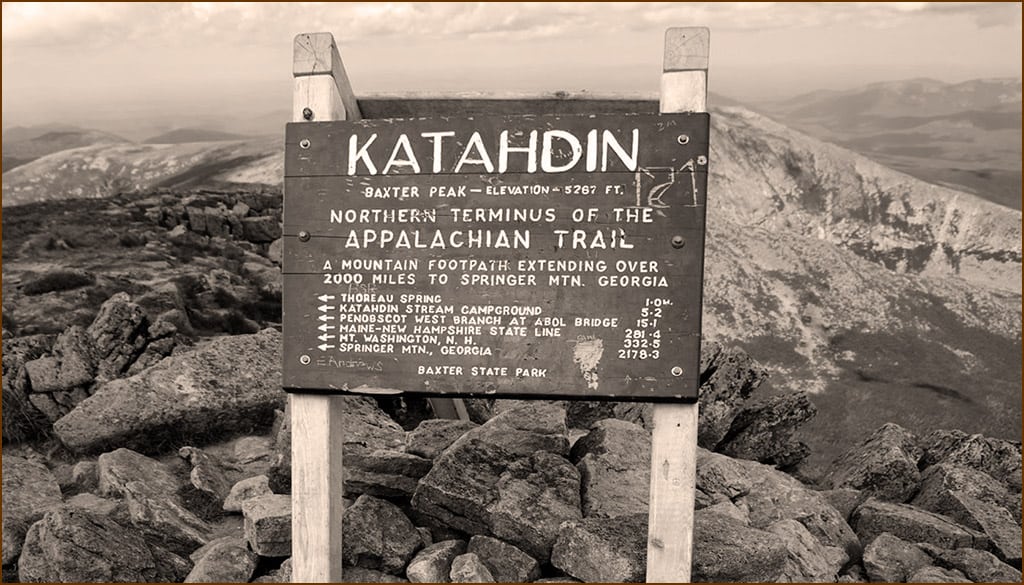
On September 25, 1955, after five months in the wilderness, her feet swollen two sizes and having worn out several pairs of sneakers, she had accomplished her goal.
Throughout her journey, reporters flocked to her like cats to catnip. People clipped news articles and watched her on the evening news, rooting her on while worrying about her survival — an older woman, alone, in such a hard place. Little did they know she was already a survivor.
Domestic violence and abuse
To those who followed her journey, Emma Gatewood was a media darling and celebrity. But there was a lot they didn’t know about her — details that only emerged decades later when a reporter named Ben Montgomery wrote a book titled “Grandma Gatewood’s Walk,” published in 2014.
Married at 19, she had survived more than 30 years of severe beatings and sexual abuse that began soon after her wedding. Almost beaten to death several times, her husband once beat her with a broom with such force he broke the broomstick over her head. Her children told Montgomery their father forced himself on their mother several times a day and threatened to commit her to an insane asylum if she ever tried to leave him.
The beatings and abuse continued until one day her husband broke her teeth, cracked her ribs and bloodied her face. Gatewood responded by throwing a sack of flour at him. But when police arrived, she was the one arrested and jailed. The local mayor, learning she was the victim of severe domestic violence, released her, offered a safe place to stay, and found her work in a restaurant.
While she was at work and her three youngest children were in school, her husband cleaned out the house and left, never to return. After 33 years of marriage, Gatewood divorced him in 1941.
Legacy
Emma Rowena Gatewood died of a heart attack in 1973 at the age of 85, and was buried in Ohio Valley Memory Gardens, just 28 miles from the place she was born.
Inducted into the Appalachian Trail Hall of Fame in 2012, she is the subject of an exhibit in the Appalachian Trail Museum whose citation reads, in part, “She inspired two distinct movements in long-distance hiking — women thru-hikers and the ultra-lite movement.” As of 2016, women were 29% of thru-hikers on the trail compared with 15% in earlier decades.
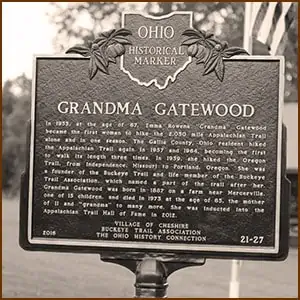
More importantly, she left an indelible mark on the Appalachian Trail itself. Completed in 1937, by the 1950s it was a patchwork of local trail systems with no federal oversight or management. A 1938 hurricane had destroyed parts of it the same year 120 miles were displaced by the Blue Ridge Parkway. And once America entered World War II, work on the trail stopped for most of the 1940s. Emma Gatewood’s celebrity and widely-reported descriptions of poor trail conditions are thought to have spurred sorely-needed repairs and restoration, and may have saved the Appalachian Trial from falling into ruin.
“Because I wanted to”
People have always wondered why Emma Gatewood decided to hike the Appalachian Trail. Her biographer speculated, “I’m not sure she was walking toward something so much as she was walking away.”
But in May of 1955, Emma Gatewood was completely free, her children grown and having to answer to no man. So when one reporter asked why she did it, her explanation was simple: “Because I wanted to.”
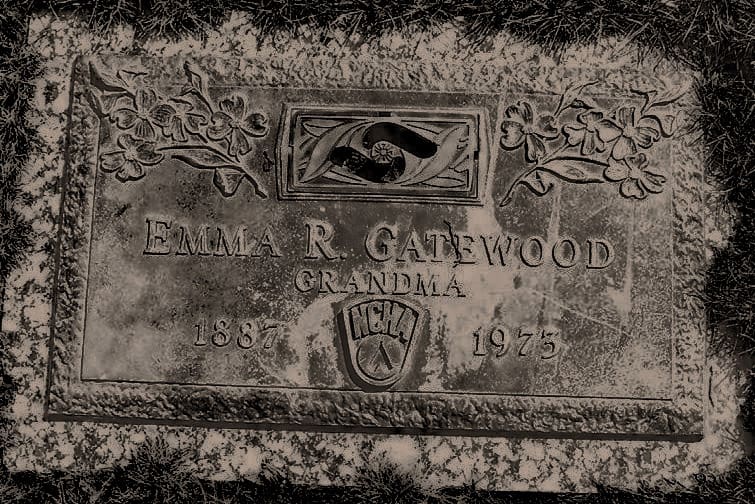

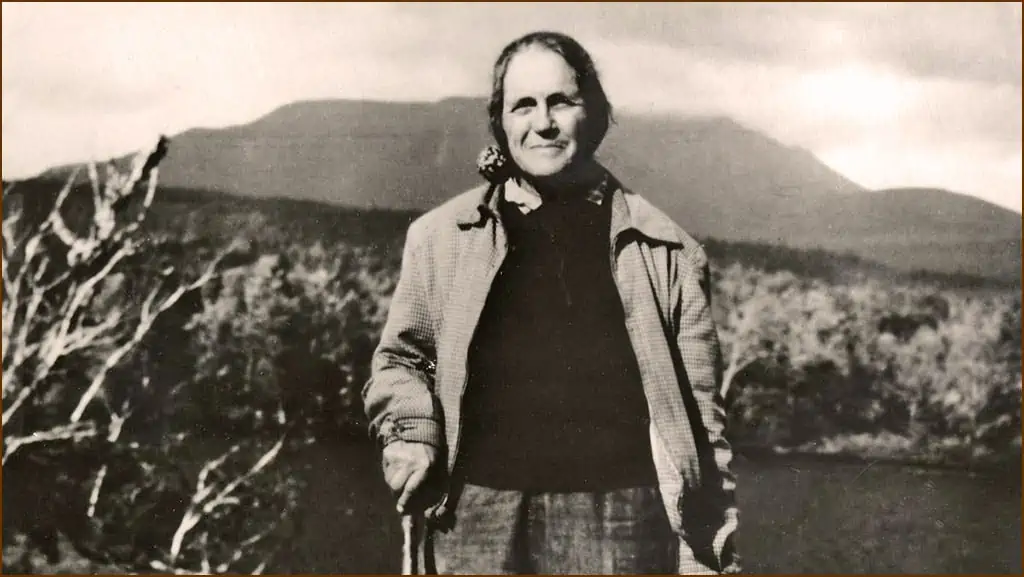
Wonderful hiker. She change my life